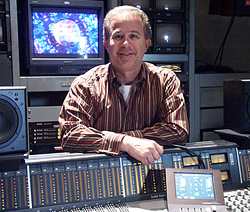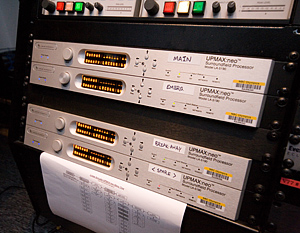Bringing Audio Into the 5.1 Age
by Steve Harvey
LOS ANGELES
When it comes to the question of whether television audio should be mixed discretely or upmixed for 5.1 surround broadcast, the answer, even from manufacturers of products that synthesize six-channel surround from mono or stereo, is universal.

Evan Edelman mixes audio for ABC's "Dancing With the Stars." "We're not saying it replaces great mixing," said Jeff Riedmiller, senior broadcast product manager, Dolby Laboratories in San Francisco. "But there are some cases where we find some customers want to create a better, more seamless experience going from a program that has been mixed truly in 5.1 to a set of commercial breaks that are in stereo and back to the 5.1 program."
Dolby now has a user-upgradeable option to add its new proprietary upmixing algorithm to the DP600 program optimizer. Initially introduced to support file-based loudness normalization, the device is now beginning to attract interest for its upmixing capabilities with one particular broadcast industry segment, according to Riedmiller.
"We're seeing a lot of the cable guys, the MSOs and the media sales arms of those companies beginning to utilize the DP600 across the country for loudness correction on ad insertions," he said. For HD ad insertions, "they are considering taking those two-channel assets and, while they are doing loudness correction, make a 5.1 mix. It can all be done is a single pass and all automated."
Tim Carroll, president of Linear Acoustic in Lancaster, Pa., also stresses that discrete 5.1 production trumps everything. "We build upmixers as things to solve little intermediary problems," he said. "Our primary product is 5.1 processing."
IT'S THE INFRASTRUCTURE

Ed Simone, chairman, TC Electronic Those problems solved by upmixing products are often infrastructure-related. With the industry still largely in transition to discrete 5.1 audio, it's not unusual for production facilities to still be working in two channels. For example, ABC's "Dancing with the Stars," a ratings juggernaut, is mixed on Stage 46 at CBS in Hollywood on a stereo SSL console, points out Ed Simeone, chairman of TC Electronic, a Danish company specializing in audio processing technology.
TC Electronic introduced its DB-4 and DB-8 broadcast processors to maintain consistent loudness within programs as well as across the boundaries between programs and differing content types, such as promos and commercial pods. Those products also include UpCon, the broadcast equivalent of TC's proprietary Unwrap recording and post-production upmixing algorithm, with some added unique bells and whistles.
"It is never meant to replace a true 5.1 mix," said Simeone. "Where it is used is where that becomes impractical. Let's say the network is producing a 5.1 signal on their HD stream for eight hours a day. What about the other 16 hours? If a station wants to remain 5.1, this box does that, besides doing an ITU-R BS.1770 loudness control at the same time."

Linear Acoustic UPMAX:neos were used by NBC at the 2008 Beijing Olympic Games. In the case of "Dancing," according to Simeone, mixer Evan Edelman is using the DB-8 for its multiband compression capabilities, passing via a Dolby encoder then by fiber to New York. Edelman is also using UpCon to generate a real time 5.1 upmix. "In the control room, Evan is able to monitor using a Dolby box, constantly monitoring what's coming out of the console in stereo, what's coming out of the DB8 in 5.1, and what the Dolby Lt Rt downmix is," he said.
Numerous Linear Acoustic upmixer units were utilized by NBC at the 2008 Beijing Olympics, according to Carroll.
The UPMAX:neo "was only used when there was just no other way to carry discrete audio," he said. "By and large most of the content that was broadcast across the country was purely discrete, and upmixing was used to roll in the interview pieces and that sort of thing, for the first time ever." Perhaps 70 percent of the audio was discrete 5.1, he believes, but with no 5.1 infrastructure in the edit bays, there was no alternative but to upmix certain content.
Also "[Linear Acoustic products] are helping to solve some other infrastructure issues, one of them being the need to rely on metadata to control the final Dolby encoder," Carroll said. "In some cases, when it's switched between two-channel and 5.1 that mode switch can cause audible clicks and other disturbances to the consumer listening in 5.1. Even if they wanted to upmix it into just three channels, LCR—which is something PBS has been talking about doing—gives the broadcaster the control of that content."
ANCHORING THE DIALOG
Consultant Roger Charlesworth, who has worked closely with NBC in New York for many years, is an advocate for a 5.1 infrastructure, whether programming is mono, stereo or upmixed. "Upmixing does give you center channel compatibility, but I think that's the only thing that it guarantees you," he said.
Charlesworth suggests that stations should make a commitment to a 5.1 platform. "For the consumer, it supports two-channel in a way that is completely predictable," he said.
The 5.1 platform has an advantage for news and informational programming—content that is typically locally produced and inserted between the 5.1 network feeds—over stereo. "It's as compelling for news and informational programming as anything else because it anchors the dialog," Charlesworth said. "If it's just talking heads on a Sunday morning show then this is a perfectly appropriate format, to have them come out of the dialog channel, in terms of intelligibility and lack of comb filtering."
Local news and informational content tends to be mono, Charlesworth adds. "So if you mix stereo first and then upmix it you get center channel compatibility but you don't get the intelligibility boost because you end up with something that is very narrow."
There is a simple solution: "If you have a report from the field with a mono camera mic and a mono mic on the person doing the standup you have some diversity. In 5.1 you can treat them symmetrically, and put the dialog in the center where it belongs and you can put the natural sound on left and right. You have the intelligibility boost and a wide image, and that's more than mono. You don't really have stereo, so if you mix it in stereo you're making it mono."
Get the TV Tech Newsletter
The professional video industry's #1 source for news, trends and product and tech information. Sign up below.
